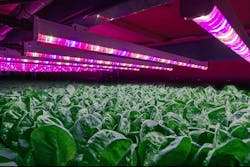Domaine Vincent spans apple tree cuttings to lettuce in LED-lit CEA farm
Most controlled environment agriculture (CEA) operations don’t start life as an apple orchard, but such is the evolution of the Domaine Vincent farm in Saint-Joseph-du-Lac, Quebec, Canada. Engineer turned farmer Marc Vincent first used LED lighting to accelerate the growth of apple trees, later established unique vertical farming technology for leafy greens, and plans to tackle strawberries going forward. Arize luminaires from GE Current, a Daintree company provide the energy the plants need while distributor Hort Americas has supplied other AgTech elements to automate the operation.
Vincent and his wife Aude bought the farm based on a love of equestrian pursuits and settled into country life. He had previously worked in an industrial setting where automation was a key focus in the technology-centric environment. The farm also featured an apple orchard that had been abandoned and that orchard motivated Vincent toward what would become a CEA future.
The uncontrolled Canadian environment immediately imposed challenges to the neophyte apple farmer and hailstorms in consecutive years wiped out crops. It would require a creative mind to devise a way to use a CEA setting and AgTech including solid-state lighting (SSL) with an apple crop. But Vincent had a plan and was also learning about using LEDs to grow leafy greens in a CEA setting.
Vincent said he spent five years working to find the best lighting and to learn how to match recipes to cultivar. Such light recipe research has been widely discussed at our HortiCann Light + Tech conferences (formerly the Horticultural Lighting Conferences). For Vincent, a move to GE Arize luminaires combined with consulting by Hort Americas was key.
Clearly, Vincent couldn’t find the CEA space need to grow apples under cover, so what did he do, you ask? At any given time, he might have 1000 apple tree cuttings growing under 100 Arize Element L1000 luminaires. In two months within the CEA setting, the cuttings advance to a height that would require a full year in the orchard. We often write about accelerating time to market relative to a technology development, but Vincent is doing just that with apples. “In the end, we gain two years on the entire process, which makes us competitive on the market,” said Vincent.
Meanwhile, Vincent is germinating lettuce under Arize Link light bars. The lettuce ultimately is moved to a sterile room where it is grown in vertical towers under the Arize Element L1000 fixtures. The farm uses an aeroponic system where roots are exposed to a mist of nutrients and water. We first heard the use of the term aeroponic relative to vertical farms run by Aero Farms.
The lettuce operation is largely automated and a huge change for anyone that has worked in traditional field techniques. “When it rains on a field of lettuce, there’s nothing for the farmer to do but wait,” says Vincent. “With an indoor farm, you need to be vigilant 24 hours a day. For example, if the air conditioning stops for two hours, the impact will be felt for days. Or if the balance between temperature, light, and humidity is disrupted, you need to intervene as soon as possible to avoid losing everything. When growing this type of crop, an automated alarm system is indispensable.”
The lighting environment is controlled at the Domaine Vincent farm precisely. Sunrises and sunsets are simulated and elements such as temperature and humidity are controlled continuously. You will see much more about such total environmental controls at our upcoming HortiCann Light + Tech Conference 2021.
Vincent is also growing peppers using hydroponic technology. The SSL for the peppers is adjusted for the different stages of growth. And as mentioned, Vincent has other CEA cultivars in planning while also growing melons, radishes, and other vegetables.
Turning back to HortiCann to close, we will have an outstanding program. One of the highlights will be the Plenary Growers panel hosted by Erico Matos of GLASE. Participants will include Tessa Pocock of Shenandoah Growers, John McMahon at Schuyler Greens, and Tammam Serage of Revolution Farms.
LEDs Magazine chief editor MAURY WRIGHT is an electronics engineer turned technology journalist, who has focused specifically on the LED & Lighting industry for the past decade.
For up-to-the-minute LED and SSL updates, why not follow us on Twitter? You’ll find curated content and commentary, as well as information on industry events, webcasts, and surveys on our LinkedIn Company Page and our Facebook page.

Maury Wright | Editor in Chief
Maury Wright is an electronics engineer turned technology journalist, who has focused specifically on the LED & Lighting industry for the past decade. Wright first wrote for LEDs Magazine as a contractor in 2010, and took over as Editor-in-Chief in 2012. He has broad experience in technology areas ranging from microprocessors to digital media to wireless networks that he gained over 30 years in the trade press. Wright has experience running global editorial operations, such as during his tenure as worldwide editorial director of EDN Magazine, and has been instrumental in launching publication websites going back to the earliest days of the Internet. Wright has won numerous industry awards, including multiple ASBPE national awards for B2B journalism excellence, and has received finalist recognition for LEDs Magazine in the FOLIO Eddie Awards. He received a BS in electrical engineering from Auburn University.





